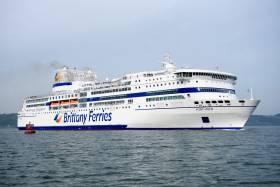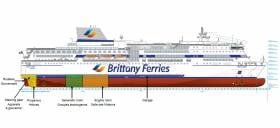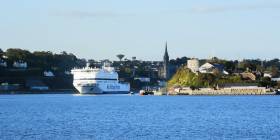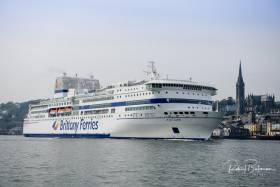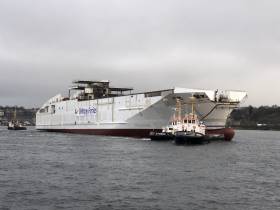Displaying items by tag: Brittany Ferries
More Ireland-France Sailings Cancelled As Brittany Flagship Is Off Service for Repairs
Brittany Ferries have been forced yet again to cancel sailings on its Cork-Roscoff route due to operational reasons as flagship Pont-Aven continues to be beset with technical issues, writes Jehan Ashmore.
Currently Pont-Aven remains in dry-dock at Damen Shiprepair, Brest, following an hydraulic problem which took place in mid-May while on a sailing from the UK to France.
The incident led in turn to cancelled sailings on the Ireland-France route where affected passengers to date and next weekend (1 June) have been offered to defer the sailing to a later date (subject to availability) or cancel and receive a full refund.
Brittany Ferries are in the process of assisting customers and await a confirmed date of Pont-Aven's return (see updates) in addition the operator have taken the precaution of blocking any further bookings on cruiseferry between now and 7 June.
Communication of developments will also be made as soon as possible via our sailings update page.
An in-depth investigation has begun by the French operator into the incident.
Commenting about the incident Christophe Mathieu, Brittany Ferries CEO who said “We are all truly sorry for the further problems with our flagship vessel Pont-Aven. Unfortunately she has suffered two technical problems in rapid succession. While the previous engine problem, which reduced the ship’s speed from 24 knots to 20 knots, is entirely unrelated to the current steering gear issue, the consequence of further bad luck is significant inconvenience for our passengers."
The German built Pont-Aven is fitted with two entirely independent Rotary Vane steering gears, each operating one of two rudders. These are self-contained units positioned at her stern directly above the rudders . Hydraulic oil is injected at high pressure into a series of chambers which operate the rotating part of the steering servo-motors. As these chambers fill, the rotor turns, thus moving each rudder in the desired direction.
According to Brittany Ferries, Pont-Aven’s engineers were alerted to low oil pressure in the starboard steering gear. An oil leak was identified which caused the pressure loss and a reduction in steering capacity. Under these circumstances, the decision was immediately taken to take Pont-Aven out of service in Roscoff, for investigation and remedial work to be carried out in Brest.
Unfortunately, following further investigation it was found that damage to the starboard side steering gear was more extensive than originally suspected. This has meant a longer lay-over in Brest than originally planned to source replacement parts and carry out a comprehensive repair.
A repair procedure has been defined with the agreement of Bureau Veritas (certification authority) and the manufacturer. In parallel, a complete check of the port steering gear has been carried out.
Cancellations of four Brittany Ferries services to and from Cork is unfortunate but the onus has to be to look after the passengers affected, according to chief executive of the Irish Travel Agents Association Pat Dawson.
As Echolive.ie reported (yesterday's) ferry from Cork to Roscoff in northern France was cancelled due to a technical problem with the vessel, Pont-Aven, while a separate issue with the Connemara vessel between Cork and Santander in northern Spain meant that this voyage was also not running on Friday.
Almost 1,500 passengers were affected by the cancellations.
Speaking to The Echo, Mr Dawson said: “These things happen in all walks of life. There isn’t much you can do about it, but when something like this goes wrong, all you can do is look after those affected.”
Mr Dawson said all passengers who were supposed to board the ferry to France or Spain with Brittany Ferries are entitled to compensation under the Flight Compensation Regulation 261/2004 which governs flights and ferries in terms of cancellations.
Click here for further reading on this story.
For the latest update on Pont-Aven (including passenger FAQ) in addition to status of sailings including those on UK (Plymouth)-Spain service click here
Several scheduled sailings the Irish Examiner reports between Cork and mainland Europe have been cancelled by Brittany Ferries.
All planned sailings to and from Roscoff, France have been cancelled until May 31.
The routes affected are Roscoff to Cork tomorrow, May 24, and Cork to Roscoff on Saturday.
The cancellations are due to "a technical problem with the Pont-Aven ferry," according to the company.
Brittany Ferries has apologised for any inconvenience this has caused and in a statement said customers affected are being offered a full refund or an alternative sailing.
"Brittany Ferries sailings from Roscoff-Cork (May 24) and Cork-Roscoff (May 25) have regrettably been cancelled due to a hydraulic fault on the Pont-Aven affecting its rudder, the repairs for which have taken longer than first anticipated," a spokesperson said.
"We are currently contacting all passengers scheduled to travel the route tomorrow and Saturday to offer assistance.
To continue reading this story (click here) on the 40,000 gross tonnnage cruiseferry which is currently dry-docked in Brest at Damen Shiprepair.
Afloat adds Armorique (see above photo) previously deputised on the Ireland-France service also this month because Pont-Aven had another incident during a crossing between the UK and Spain. This necessitated a detour to Brest from where passengers were safely disembarked.
On that occasion Pont-Aven used the same dry-dock in Brest to undergo repairs.
As for Armorique, this cruiseferry routinely serves on the English Channel between Portsmouth and Caen (Ouistreham). The ferryport in Normandy is adjacent to the beach (codenamed 'Sword') which formed part of the Allied invasion when the D-Day Landings took place on 6th June 1944.
Commemorative services to mark the 75th anniverary of that momentous day will be held in less than fortnight's time.
New Look Brittany Ferries Gets A Boost In Passenger Bookings
#ferries - It's a busy time for Brittany Ferries as the Easter Holiday is well underway with passengers travelling on the Cork-Roscoff seasonal service, writes Jehan Ashmore.
On Good Friday the flagship cruiseferry Pont-Aven departed from France to arrive in Cork the next day before returning with Irish holidaymakers to Roscoff, Brittany. The Ireland-France route which this year is running its 41st season had resumed service last month.
As previously reported on Afloat.ie, the cruiseferry Pont-Aven sports a new livery scheme incorporating an updated logo and typeface. The new more colourful look comes with an announcement by the French operator of a 16% rise in bookings for 2019 in the Irish market.
Figures for 2018 show that the French company reported a 12% increase in the number of passengers on the route when compared to the previous year. The Ireland-France route had carried more than 97,000 passengers last year.
According to TravelExtra, Brittany Ferries hope to capitalise on the decision by Irish Ferries to drop Rosslare based routes to France by enticing holidaymakers in the south-east to travel to Cork rather than Dublin Port.
In addition Brittany Ferries also operate Cork-Roscoff sailings on Monday's. This weekday crossing to the continent is served by Connemara which offers an 'economie' style service.
The chartered in ropax is also kept busy by maintaining Ireland-Spain duties on the year-round Cork-Santander service launched almost a year ago. This is the first ever direct Ireland-Spain link.
Brittany Ferries Boss Re-Elected President of French Chamber of Shipping In Advance of EU Summit On Brexit Extension
#ferries - A Breton farmer and boss of Brittany Ferries Jean-Marc Roué has recently been re-elected president of Armateurs de France, the French equivalent of the UK Chamber of Shipping, writes Jehan Ashmore.
This afternoon the UK Prime Minister, Theresa May is to make a plea at an EU emergency summit in Brussels, by proposing to all 27 leaders to delay Brexit with an extension date of 30th June.
The ferry operator Armement Bretagne-Angleterre-Irelande, or B.A.I. officially began sailing on 2 January 1973, just a day after Britain joined the Common Market of the European Economic Community (EEC) a predecessor of the EU.
B.A.I. which trades as Brittany Ferries, was founded by Alex Gourvennec who saw this chance to end the geographical isolation of Brittany by exporting vegetables to the UK marketplace.
A ro-ro freighter was purchased and renamed Kerisnel, a small Breton village made famous for its cauliflowers. The first sailing took place from Roscoff to Plymouth, Cornwall.
To this day, farmers in the most western region of France remain the company's main shareholders.
Click here for related story of the UK Government's contract announced in December last year with the ferry operator to ease potential problems in the event of a no-deal Brexit.
Every Little Helps As Brittany Ferries Propel Pont-Aven With Additional Sub-Propellors
#ferries - Brittany Ferries Cork-Roscoff cruise-ferry Pont-Aven began today its first sailing in 2019 on the seasonal route and will save energy and reduce fuel consumption thanks to the installation of two innovative devices on the ship's propellers.
Wärtsilä‘s EnergoProfin system is a small sub-prop, which is attached to the main propeller helmet, helping improve propulsion in water. Two of these devices were installed during the ship’s dry dock in December 2018. As a consequence fuel consumption and emissions have been cut by around 2% on every crossing.
This project is a small – but significant – step and it comes as part of a range of studies initiated through Brittany Ferries’ Research and Development program. But, as Vincent Coquen, Head of R&D, Energy and Environment for the company, explains, it is not just a question of developing practical and technical solutions for today such as the propellers on Pont-Aven.
“Sustainable development means looking to the future and studying innovative projects and technologies that could be used in either the short or longer term,” he said.
For the past two years, Brittany Ferries has partnered with CEA Tech in France. Several projects are underway, including the development of a long-range broadband link that would use land-based transmitters to obviate the use of satellite-at-sea. A second study focuses on hybrid energy solutions for Cap Finistère, Brittany Ferries cruise-ferry that sails from the UK to Spain. The last is exploring the long-term implementation of fuel cells for powering certain of the ship's on-board systems.
Brittany Ferries is also looking at the potential for wind energy. Flettner rotors, traction wings, or modern sails are at different stages of development, but could significantly reduce ship fuel consumption and therefore emissions.
“Of course, we must be cautious, checking the feasibility of integrating these technologies on board our ships, in terms of safety, reliability and profitability,” added Vincent Coquen. “But I am convinced that they will have a significant role in the equation that ship-owners must solve to achieve the zero emissions ship.”
Fourth New Brittany Ferries Cruise Ferry, Post-Brexit
#ferries - In an announcement today Brittany Ferries has said it is to charter a third brand new cruise-ferry to serve its long-haul routes.
The newbuild to be powered by LNG (liquefied natural gas), will be built at the AVIC Weihai Shipyard in China and is due to join Brittany Ferries’ network in 2023.
The news follows trading results for 2018 which includes Cork-Roscoff which saw an increase in both passengers and freight compared to last year.
As yet the unnamed ship will be chartered from Stena RoRo and will be built to the Swedish shipowner’s E-Flexer design. Its arrival will bring to three the number of E-Flexer class ships in Brittany Ferries’ fleet following the arrival of Galicia in 2021 and Salamanca in 2022.
The operator is also constructing another new ship, Honfleur, at the FSG shipyard in Flensburg Germany, for delivery expected in late 2019 (see related story on delay)
The charter agreement, which includes an option to purchase, represents the next step in a fleet renewal and investment programme worth around €550m. It will offer increased capacity and comfort for customers as well as employment of French seafarers.
Brittany Ferries is proud to be the largest employer of French seafarers and is committed to fleet renewal and a more sustainable future.
Like Salamanca and Honfleur, the new ship will be powered by Liquefied Natural Gas (LNG). It’s a fuel which presents major environmental advantages over conventional maritime fuels, reducing carbon dioxide emissions by around 20% and cutting sulphur dioxide, nitrogen dioxide and particulate emissions to almost zero.
Brittany Ferries’ CEO Christophe Mathieu comments: “We’re delighted to be adding another E-Flexer class cruise-ferry to our fleet. These are environmentally-friendly, capacious and comfortable ships which perfectly suit to our long-haul services.
“The charter will continue our fleet renewal plans, marking the fourth brand new ship in five years. It signals our confidence in the demand for ferry travel post-Brexit and will help us meet the needs of our passenger and freight customers in the decades to come. It also clearly demonstrates our commitment to LNG as a fuel and, our ambition to operate one of the most modern, green and comfortable ferry fleets in the world.”
The three 42,200 tonne E-Flexer class ships will be amongst the biggest in Brittany Ferries’ fleet. Each will be 215 metres long with 3,000 garage lanemetres for freight vehicles, and capacity for around 1,000 passengers in 340 en-suite cabins.
Three passenger decks will contain a range of boutiques, restaurants, bars and cafes all decorated to offer a rich and inspiring Spanish style giving customers a colourful foretaste of Iberian landscapes, towns and culture as they sail.
Brittany Ferries Reveal Results for 2018 & Urges French Authorities to Keep Trade Flowing Freely Post-Brexit
#ferries - Brittany Ferries resumed service on the Cork-Roscoff seasonal route last week and has recently revealed passenger, freight and financial results for 2018.
According to figures revealed by Brittany Ferries, passengers using the Ireland-France route totalled 86,388 (2016-217) and 97,174 (2017-2018) an increase of 12.5%. In terms of freight vehicles 494 were carried in (2016-2017) and 1,059 were transported during 2017-2018 a significant increase of 114.4.%
The encouraging results across the ferry operator's network come despite the pound being worth around 15% less than it was two years ago. That has proved challenging for a company whose income is generated in pounds sterling, with a cost-base in euros. Further challenges have come from on-going Brexit uncertainty and the effect this is having on summer 2019 bookings.The ferry company carried 2.6 million passengers on all routes last year, an increase of 1.4%. It made a profit of €8 million on a total turnover of €442m.
Brittany Ferries is a French company. But its success is largely built on British customers. In total, 85% of passengers come from the UK. It has therefore used its 2018 results to reinforce an important message to French government: take urgent steps to ensure British holiday makers and freight move freely. The regions of north west France depend upon Brittany Ferries as a significant wealth generator.
On 7 March 2019 Jean-Marc Roué, Brittany Ferries’ president, hosted Jean-Yves Le Drian, the French Minister of Europe and Foreign Affairs. Showing him around Roscoff port and its facilities, Roué talked at length about border controls and customs, as well as health and sanitary checks for goods arriving in France.
“Jean-Yves Le Drian told us that Roscoff will become a border post on the 29th March 2019,” said Roué. “In my view, the return of a border between France and the United Kingdom fully legitimises the return of dedicated air and border police. These Police Aux Frontières (PAF) would work alongside customs services in the same way they currently do in ports like St. Malo, Cherbourg and Le Havre. It is only a short-term solution in the event of a hard Brexit, but I am counting on the Minister to relay this proposal to the Government”
Concerns in France come as planning to minimise traffic queues on the UK side intensifies. Portsmouth, for example, is Brittany Ferries’ UK-hub. Recent exercises led by the Local Resilience Forum suggest that carefully managed traffic solutions can prevent freight delays en-route to the port, should the UK leave the EU without a deal on March 29th.
“We made a profit in 2018 thanks to a combination of careful management and structural change,” added Christophe Mathieu, CEO of Brittany Ferries. “Our positive results come despite the pound being worth significantly less than it was two years ago and as Brexit uncertainty weakens demand for trips to France and Spain this summer.
“We are now preparing for the years ahead. We have invested in three new ships and have made a clear commitment to the regions we serve. The challenge now is one for the French government in particular. All steps must be taken to ensure we have the right frameworks in place in Brittany and Normandy post-Brexit to keep goods flowing freely and to ensure our British passengers have the confidence to sail this summer and in the years to come.”
Brittany Ferries operates 11 routes linking the UK, France, Spain and Ireland with twelve ships, four of which are chartered. In the UK it operates services from Portsmouth to four destinations in France and two in northern Spain. From Poole it sails to Cherbourg and operates a freight-only service to Bilbao.
Plymouth has been linked to Roscoff since the company’s first sailing on 2 January 1973, the day after the UK joined the Common Market (forerunner to the EU). Today ferries also link Plymouth with northern Spain.
More than half a billion euros were spent by Brittany Ferries’ customers visiting France last year. There were 854,000 unique visitors, staying 9.2 million bed-nights. Brittany, Normandy and the Loire were the biggest regional winners. Brittany hosted 295,000 visitors generating €150m in wealth for the region. Normandy welcomed 219,000 guests who spent €78m; the Loire received 143,000 visitors who spent €78m, thanks to British customers.
Three new ships have been ordered post-Brexit, following an investment of €450m in the company’s future. Two of these ships will be powered by LNG (liquefied natural gas), a fuel that reduces sulphur and particulate emissions to almost zero and cuts average CO2 (carbon dioxide) output by around 20 per cent.
When the newbuild arrives at the end of the year, Honfleur will be the first ferry on the English Channel to be powered by LNG. As well as environmental credentials, the new ferry will also embody the company’s drive towards a digital future and ambition to reveal even more fabulous destinations around the coastlines of the European west.
Hull of Brittany Ferries’ LPG Powered Honfleur Takes to the Water at German Shipyard
#ferry - The hull of Brittany Ferries’ brand new LNG-powered cruiseferry Honfleur for English Channel service, was today given a traditional ship launching ceremony at the FSG shipyard in Flensburg, Germany.
At midday, hundreds of well-wishers, invited guests, shipyard workers and Brittany Ferries team members lined the quaysides. From there the crowds saw the completed hull of the vessel slid down the historic building slipway and into the chilly waters of the Flensburg Fjord.
The launch is the third milestone in the construction of Honfleur, following cutting of the first steel in March, and laying of the keel in August.
Since the keel was laid, 118 huge steel hull sections have been welded together on the slipway to create the 10,000 tonne six-storey behemoth before launching. The completed hull already contains all the ship’s main machinery including its efficient and environmentally-friendly LNG-electric propulsion system.
The launch marks Honfleur’s place in a long and historic line of ships to be constructed at the Flensburger Schiffbau-Gesellschaft yard (FSG) situated on the tip of Schleswig-Holstein, northern Germany. Since its foundation in 1872 more than 750 ships have been designed and built at the site.
Honfleur represents a new generation of cross-Channel ferry combining state-of-the art design and sustainable thinking with a smart, digitally-informed customer experience. The ship’s passengers will enjoy innovative experiences and fresh service concepts along with the highest standards of French onboard hospitality and catering. Altogether Honfleur will carry up to 1,680 passengers and will offer 261 cabins, two cinemas, restaurants, boutique shopping and choice of spacious passenger lounges
Honfleur will be an environmental pioneer on the English Channel. When it enters service it will be the first ship on the Channel to be powered by Liquefied Natural Gas (LNG). LNG provides major environmental advantages, reducing carbon dioxide, and cutting sulphur dioxide, nitrogen dioxide and particulate emissions to almost zero. The ship’s hull has been hydro-dynamically optimised; this combined with gas-electric propulsion machinery will reduce energy consumption while improving onboard comfort and minimising vibration and noise levels.
The launch marks the beginning of the next phase of the ship’s construction. Over the coming weeks and months, two giant superstructure ‘mega blocks’ currently en route by barge from shipyards in Poland will be hoisted into position by giant cranes, and the ferry’s attractive and modern interiors will be installed. Then, the ship will complete a series of sea trials allowing every system on board to be rigorously tested, before the first passengers board the vessel on the Portsmouth to Caen/Ouistreham route in summer 2019. The route is Brittany Ferries’ most popular carrying around 1 million passengers, 300,000 cars and 100,000 freight units each year.
Jean-Marc Roué, Brittany Ferries’ president said: “Today’s a big day for Honfleur, and a proud moment for everyone at Brittany Ferries, particularly our teams dedicated to bringing the project to fruition.”
“Honfleur will be the largest and greenest ship that Brittany Ferries has ever operated – she’ll also be the smartest: packed with new technology, innovation and comforts”, said Christophe Mathieu, CEO Brittany Ferries. “It’s a statement of our commitment to fleet renewal and long-term, sustainable development. And it will be the first of three new ships to be delivered post-Brexit, all part of a €450m investment programme to make Brittany Ferries fit for the future.”
“Now a new phase in Honfleur’s construction begins, as the superstructure is added and we work to prepare the ship to welcome its first customers this summer. We can’t wait to show them everything Honfleur has to offer.”
For more information and to follow the progress of the build from now until entry into service visit the Honfleur website.
Fresh New Look to Be Rolled Out Across Brittany Ferries Fleet
#ferry - A fresh new look involving a splash of colour across the Brittany Ferries fleet sees a bright new logo in striking shades of blue, orange and green!
The new design, which comes with a more modern, warm and lyrical typeface, will be applied to each ship during refit, and will eventually be emblazoned on the side of every vessel’s hull and funnel.
The logo according to Brittany Ferries is the result of extensive customer research. The design more truly reflects the fullness of the ferry operator's experience: the richness of travel by sea, the warmth of the welcome ashore and on board, and the spirit of discovery for some of Western Europe’s most beautiful holiday destinations.
As well as a ferry operator Brittany Ferries is a holiday company too, with four decades of experience arranging sail-and-stay packages. Today the company offers thousands of hotels and holiday properties in France, Spain, Ireland and the UK making it one of Europe’s leading tour operators. The new logo reflects its destinations, with blue, green and orange shades evoking the seas, landscapes and skies of the holiday regions Brittany Ferries serves
On the Irish services, Afloat adds is the Cork-Roscoff (seasonal) service that ended earlier this month (see Pont-Aven's Route du Rhum story) though the newly launched first ever direct Ireland-Spain route of Cork-Santander continues sailings on a year-round basis.
The new visual identity comes as part of a multi-million euro investment to make Brittany Ferries fit for the future. Three brand new ships are currently under construction and due to join the fleet in 2019 Honfleur, 2021 Galicia and 2022 Salamanca, see story. Afloat adds Honfleur, a LPG powered ferry under construction at the FSG yard in Germany, is to enter English Channel service between Portsmouth-(Oustreham) Caen.
A wide-ranging digital transformation programme is also underway, aimed at enhancing every aspect of the customer experience from researching to booking, checking-in, sailing, holidaying and returning home.
Florence Gourdon, marketing director explains: “This is the right time for an exciting change. We last evolved our logo 15 years ago (see Bretagne, former flagship on Irish route) and so much has changed in that time – for example we now live in a digital world. And while the previous logo fully communicated the reliability and trustworthiness of our ferry service, it didn’t fully embody the emotional side of travelling and holidaying with Brittany Ferries and the discoveries inherent in the fabulous destinations we serve.”
“This new look stands for everything that makes our brand: the quality of our products and services, the passion, pride and professionalism of our teams, and our bright future with brand new ships and rich experiences on the horizon.”
The new design was first glimpsed by eagle-eyed ship spotters at the shipyards where Armorique and Pont-Aven are currently undergoing winter refits.
Afloat adds Pont-Aven is recieving such work as part of routine winter drydocking in Spain at the Astander Yard in Astilleo. The flagship having shifted on 11 November from nearby Santander where the direct continental Cork service as previously mentioned is maintained year round by the chartered-in ropax tonnage, Connemara.
The ships from the fleet will shortly return to service sporting the new look. The new logo will be unveiled further over the coming days. Then, and throughout 2019 it will be rolled out across all Brittany Ferries sites, marketing and operations including everything from signs, brochures, uniforms, to advertising and websites.


























